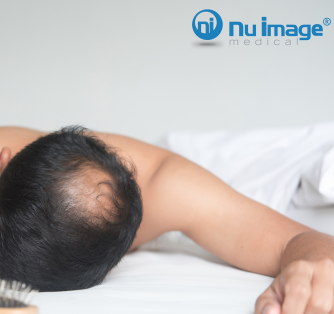Menu
Weight loss
Hormones
Sex
EXPLORE
MEET NU IMAGE MEDICAL
TREATMENTS
MEET NU IMAGE MEDICAL
TREATMENTS
MEET NU IMAGE MEDICAL
Cultural Impacts on Traction Alopecia


When it comes to your health and your ability to develop muscle, burn fat, or grow hair, a lot of people want to blame genetics on why things don’t always work out in their favor. Although genetics can influence certain things, you can’t lay all your health problems at the feet of your parents or grandparents. Lifestyle choices, whether it be what you eat, how much you exercise, or how well you manage stress, can all factor into your overall health. When talking about health, every organ in your body is affected by your choices. Did you realize that each hair strand grows from a tiny organ called a hair follicle? What you put in your body and what you do to your body has a direct effect on your hair growth.
While genetics and aging can affect how fast your hair grows, how strong it grows, and the color of the strands, lifestyle factors play an equally important role. Sometimes, decisions and choices for hair care and maintenance are done in ignorance but can cause significant long-term damage. Treating your hair as a sensitive and delicate organ is going to take more than just a topical conditioner or a good scalp massage. You may need to start seeing how your styling or cultural influences are impacting your ability to retain a healthy head of hair for years to come.
Cultural Influences
No one wants to deal with hair loss, but you may inadvertently be creating a scenario where that is your reality down the road. You may simply be following the expectations placed on you by your ethnic heritage or the culture around you, but when it comes to preserving your hair and promoting healthy hair follicles, you need to consider the impact it can have. Many hairstyles are associated with geographical communities, and whether you are from the Caribbean, West African, Europe, or North America, the way you wear your hair is important to both your identity but also your appearance. These are some of the cultural traditions that can negatively impact your hair health.
1. Dreadlocks
Traction alopecia is a condition that can be brought on by styling your hair in dreadlocks. This is where your hairstyle puts so much tension on your hair follicles that they become damaged. Damaged hair follicles stop re-growing hair, causing balding or thin patches. With dreadlocks, the first place to notice this occurring is around the forehead and ears. As dreadlocks grow, they get heavier and pull on the follicles all over the hair. This hairstyle is popular in areas all over the world, and dreadlocks have been around since early century civilizations. If you notice that your dreadlocks are starting to feel loose around the roots, it is time to move to another hairstyle to allow the hair to regrow.
2. Cornrows
Like the effects of dreadlocks, cornrows pull and tug on hair follicles in an unnatural way. Weak hair follicles aren’t able to produce strong hair stands or replace hair that has fallen out. Traction alopecia is a common condition African Americans or those from the Caribbean, as cornrows are a cultural hairstyle that can be worn in a decorative pattern around the head or in straight rows. The longer they are worn, the more damage cornrows can cause to your hair. It is advised that they never be worn for longer than a month. If you notice sensitivity at your scalp or you can see significant loss when you undo the rows, you should stop braiding your hair and give it a chance to recover. The more serious the loss that you experience, the less likely it is that your hair follicles will be able to repair themselves, making your hair loss permanent.
3. Extensions or Weaves
Lots of women are looking for full hair that is thick and long. Whether they are already experiencing a loss or they simply want a new look, extensions, and weaves are often used to create new hairstyles and change appearance. These products are common all across the world, but women who have straight Western styles use extensions to make their hair long or to add volume. Adding these extensions takes glue, while adding weaves takes sewing extension into braided hair. The additional weight on the hair extensions, as well as the hot glue, damages hair strands and the follicles below the scalp, turning into traction alopecia.
There is nothing wrong with wanting to identify with your cultural heritage, but in some cases, you can be doing long-term damage to your hair. While there are treatment products that can help combat hair loss, there is no cure for follicles that have stopped working altogether. Changing your hair habits can prolong the health and life of your locks, allowing you to display your cultural heritage with pride but for years to come.
Nu Image Medical® offers a new and futuristic approach to achieving optimal health and wellness. The company has been a weight loss, anti-aging and wellness provider since 2004 and offers medically supervised programs for medical weight loss, peptides, erectile dysfunction, scream cream, and hair loss (NuDew)
This article is for informational purposes only and does not constitute medical advice. The information contained herein is not a substitute for and should never be relied upon for professional medical advice. Always talk to your physician about the risks and benefits of any treatment. Nu Image Medical may not offer the medications or services mentioned in this article.
